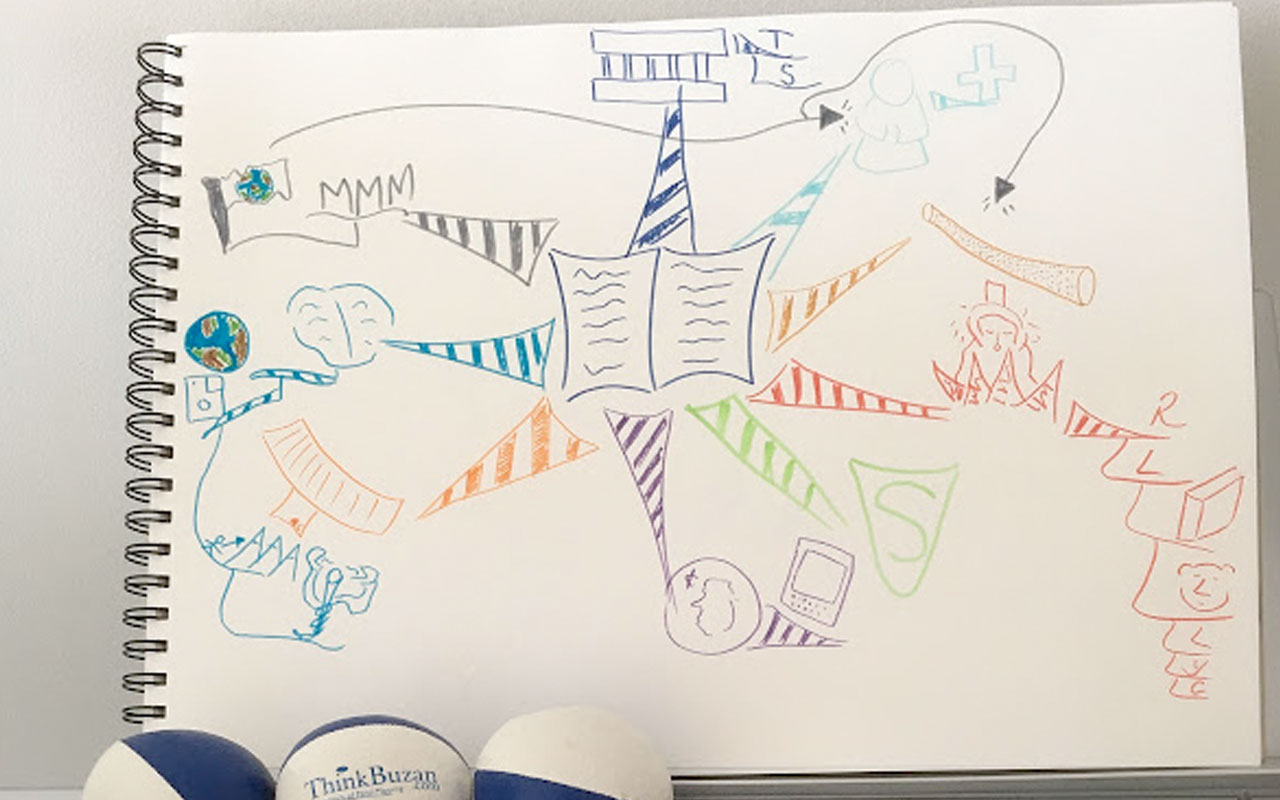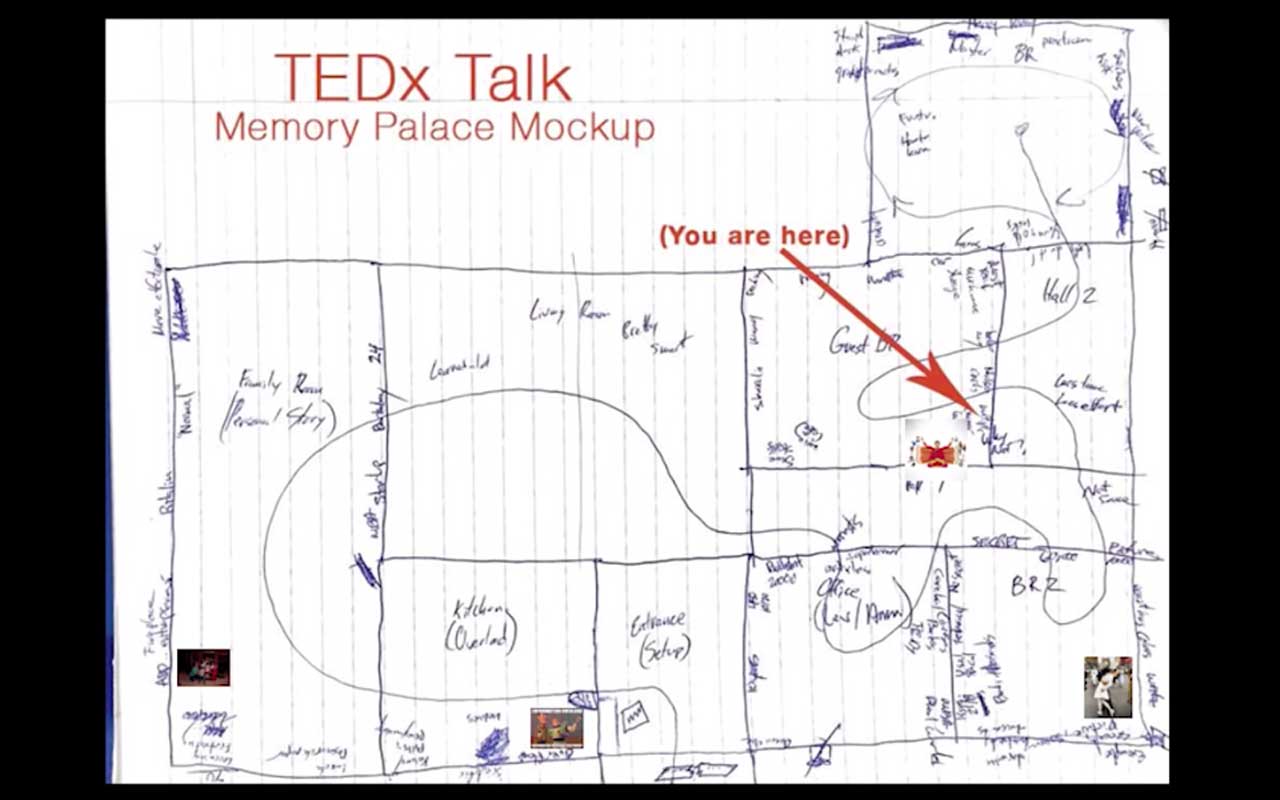How to Memorize a Speech Fast
- Get link
- X
- Other Apps
How to Memorize a Speech Fast (Without Sounding Like a Robot)
Anthony Metivier| March 19, 2020| Memory Palace Tactics
Audio Player
 Imagine this: you’re standing up in front of an audience and giving an important speech.
Imagine this: you’re standing up in front of an audience and giving an important speech.
Now tell me, how do you feel? Are your hands sweaty or your knees shaky? Is your stomach tied up in knots and feeling a bit queasy?
If you’re anything like me during my undergraduate years, maybe you even have a phobia of public speaking. Yes, it’s true. I once had a terrible aversion to giving speeches, because I took a medication for manic-depression that made me shake really, really badly.
Once, in a course on romantic poetry, I was supposed to give a speech. My hands shook, my papers rattled in my hands, and I couldn’t concentrate on my delivery of the speech… much less expressing my familiarity with the topic at hand!
Instead, I ended up frustrated and embarrassed. It was one of the most horrible moments of my scholarly career to be shaking so badly and yet have so much to say.
And to top it all off, the professor wouldn’t take me at my word — I had to go to the Behavioural Sciences Building to get a letter from the psychologist explaining that I could have an alternate assignment instead of being required to give the speech. This bad experience led to a fear and phobia of giving speeches that lasted for quite some time.
But here’s the good news: even if you have a fear of public speaking – most people do – there’s still hope. With the help of memory and a few other tricks I’ll teach you today, you can overcome your fear.
And I’ll let you in on a secret. Now, when I give a speech I really have a lot of fun!
So are you ready to kick your fear of public speaking to the curb and have fun with it instead? Let’s dive right in and take a look at how to memorize a speech — and how memorizing can help you overcome your public speaking fears.
Want to skip ahead to a particular section?
Memorizing a Speech Without Losing Your Place
How to Memorize a Speech: Tips and Techniques
Tip Number 1: Be Prepared
Tip Number 2: Relax, Relax, Relax
Tip Number 3: Don’t Make it a Big Deal
Tip Number 4: Know Your Body
Tip Number 5: Do Table Reads
Memory Palace Alternatives
The Best Way to Memorize a Speech: Create a Memory Palace
How to Memorize a Speech: Step by Step
Real-Life Examples of How to Remember a Speech
Recommended Reading for Memorizing a Speech
FAQs about Memorizing a Speech or Presentation
Have Fun Memorizing a Speech
How to Memorize a Speech: Tips and Techniques
Tip Number 1: Be Prepared
Tip Number 2: Relax, Relax, Relax
Tip Number 3: Don’t Make it a Big Deal
Tip Number 4: Know Your Body
Tip Number 5: Do Table Reads
Memory Palace Alternatives
The Best Way to Memorize a Speech: Create a Memory Palace
How to Memorize a Speech: Step by Step
Real-Life Examples of How to Remember a Speech
Recommended Reading for Memorizing a Speech
FAQs about Memorizing a Speech or Presentation
Have Fun Memorizing a Speech
You might be thinking… “but will your approach work for me?”
I can honestly say — yes! I’ve seen this method work not only for me, but also for clients of mine. Here’s one example:
Michael DeLeon wrote the other day and said:
“I’ve been training myself in the techniques of the Magnetic Memory Method. I’ve given two speeches that were, by far, the easiest for me to give because of the Magnetic Memory Method. I felt no pressure. I could relax and deliver the speech I wanted to give because there was never a fear of ‘I would lose my place.'”
So are you ready to learn some tips for memorizing a speech? Let’s start with a common fear: losing your place.
Memorizing a Speech Without Losing Your Place
When we talk about how to memorize a speech, one of the first things people often ask is what to do when you get lost. In this post, we’ll cover how to find your way quickly back, as well as a host of other issues that can arise during your speech.
We’ll also talk about Steal the Show: From Speeches, to Job Interviews, to Deal-Closing Pitches, How to Guarantee a Standing Ovation for all the Performances in Your Life, a great book by Michael Port that I’ve learned a lot from, as well as some tips I learned from my mentor about giving speeches.

The short answer is: a Memory Palace can help you be fearless, focused, and able to track back if you ever do lose your place. The longer answer? Keep reading!
To make the most of this post, take notes as you read, then start to carve a path forward to where you go out and give some kind of speech (even if it’s just to your friends and family).
How to Memorize a Speech: Tips and Techniques
Before we talk through my top tips, let’s get one big question out of the way: what’s the point of learning to give (and memorize) a speech? Whether or not you’re using a memory technique, why do you want to learn how to do it?
Here are a few benefits to being a great public speaker:
- It’s a highly marketable skill.
There are lots of companies that need someone to be able to present the value they offer – their expertise, unique selling proposition, value for the market, etc – and why customers should pick them. It’s the same for you — you want to be known as the person a company wants to hire, the one they want to promote, the one they want to give a raise.
- Public speaking displays your expertise.
Your ability to speak coherently and clearly is a key indicator to both your employer and clients that you know your stuff. When you can speak from the top of your mind without hemming and hawing or stuttering, it lets your knowledge shine.
- Stepping on stage develops courage.
Getting comfortable with public speaking takes practice — and getting out there and starting to give speeches (even if it’s just to a friend or two at first) will begin to build your courage muscle. It’s a win-win.
- Speaking shows your personality.
As you practice giving speeches, you’ll begin to develop your own personal presentation style. And the more comfortable you get, the more your personality will shine.

- Giving speeches helps build relationships.
Getting out into the community allows you to connect with people in both your personal and business networks. And if you’re still in school, it can help you build connections with your teachers and your fellow students.
- Public speaking sets you up as an expert in your field.
When you’re the one up on stage, it’s clear to the audience that you know what you’re talking about. You can prepare the road ahead by being known as the expert who has the courage to get up on stage and share their knowledge. Just look at Sunil Khatri’s speech success story.
- It helps you deliver results to other people.
Right now, your audience doesn’t have a particular set of knowledge. When you get up on stage, you’re able to give them that knowledge — and package it in a way that helps them quickly absorb it. Plus, you can do so in a way that encourages them to take action, because they’ve seen you demonstrate how valuable it is from the stage.
- Speaking can help you build your memory as you learn.
Learning to memorize a speech will help you build your memory as you go. Even if you do need notes in the beginning, you can still improve your memory as you practice your speech.
- Bonus: it’s fun!
It’s not only a valuable skill, but being able to jump up on stage and speak off the top of your mind is actually a lot of fun!
Now you know the benefits of memorizing a speech, let’s take a look at a few tips to help you along the way.
Tip Number 1: Be Prepared
The number one best technique of all is to be prepared.
This means: do your research and have the knowledge in your head that you’re presenting on. This might be obvious, but a lot of people think they can skip this step.

If you’re nervous or worried, that sense of fear often comes from the fact that you don’t know your topic well enough. At the end of the day, be prepared with solid research and actual knowledge about your subject…
Because the number one memory tool you have — is to not have to use memory techniques.
You’re here to memorize a speech, but the best way to do that is to know what you’re talking about. It will help you avoid your fears about getting lost when you know your subject backwards and forwards.
Part of giving good speeches from memory is preparation — as you prepare, memorize the key information as you go along. There are a number of ways to do this:
Use a Mind Map
Mind mapping helps you prime your memory from the very beginning, by giving it structure in space.
Imagine you’re creating a mind map — you have your central image, which primes your mind to dig deep into your memory and create a mental image around the core topic, by name. You can also use a key word that’s big, bold, and centered in your attention.

This example Mind Map was created for one of my live stream presentations. I usually juggle for a few minutes before giving a speech to get my creative juices flowing.
This allows you to think in imagery and images placed in space, and also the connections you can make by having multiple key words arranged in space.
You can also turn a mind map into a Memory Palace.
Consider Content Mapping
If you decide to memorize your speech verbatim, this is another kind of mapping that can help you with your beats.
But what do we mean by beats? When you memorize verbatim, you may want to remember things like:
- Where your pauses are,
- Where on the stage you plan to turn and look at a particular part of the audience,
- When you want to pull a prop from your pocket, or
- Any other physical cues.
You might even plan to give a speech with another person and need to remember where their lines begin.
Hat tip to Steal the Show by Michael Port for this idea.
Read Additional Books
Once you create your original mind map, then you might consider reading two or three additional books on the topic.

For example, I recently did a livestream on the topic of how to memorize a speech. As part of my preparation, I read not only Michael Port’s Steal the Show, but also the Rhetorica ad Herennium and other books on rhetoric and speaking by authors like Matthew Clark and Dan Kennedy.
Know Your Audience
One fun way to engage with your audience is to know and mention the names of your host and audience. When I give talks on memorizing names, I make it a point to memorize every name in the room — and then I address audience members by name as I give my speech.
But even more important is to tailor your presentation and speech to that particular audience. This may mean memorizing things about the audience, or things about the individuals who will be present, so you can respond on the fly.
You won’t initially have the kind of information you need to do this, but it’s easy to find. Reach out to the person who invited you to give the speech – or ask your teacher or professor – and ask them what considerations they would like included in your speech.
It’s very powerful to tailor your speech to the audience and their specific interests or concerns.
Train Under Pressure
When you’re in the middle of a speech, you ideally want to keep moving forward — even if you make mistakes or something unexpected happens.
When you memorize your speech and train yourself to give it under any circumstances, it can help you find your place when the unexpected happens. You can then quickly find where you were and keep moving forward.
Tip Number 2: Relax, Relax, Relax
The most important step of all is relaxation, and being willing to let go of your expectations.

When the light goes green and you’re live you can no longer control the outcome — but you can practice not being in control very early on. You do this through relaxation.
You will relax while you:
- Prepare your research,
- Memorize your speech,
- Practice reciting what you’re going to say from memory,
- Deliver your speech (by being relaxed ahead of time), and
- Analyze how the speech went.
The more relaxed you are during each of these stages, the more you’ll be able to effectively analyze how your speaking engagement went. This gives you the chance to think through the results in a clinical fashion and improve, rather than judging yourself on your performance.
But how do you relax at each stage of preparation and memorization? There are a few techniques you can use.
Box Breathing
This is a breathing technique that’s widely attributed to a former Navy SEAL, who used the skill set to stay calm in combat situations.
To use this technique, think of a square and follow along with your breath.
- Inhale to a count of five,
- Hold the breath in for a count of five,
- Exhale to a count of five,
- Hold the breath out for a count of five, and then
- Repeat as necessary.
This technique is really good for activating your parasympathetic nervous system and giving you some space between you and your monkey mind. The more you’re able to relax, the more you can be present to what’s happening — instead of overthinking.
You might wonder: why does the monkey mind go on and on?
Well, it’s worried what people are going to think about you! It’s worried about what happens if you make a mistake. It’s worried about what happens if people think you’re going to make a mistake.
Prepare to Make Mistakes
So here’s the deal… I guarantee you’re going to make some kind of mistake. But — it’s not really a mistake if you don’t pay attention to it. If you’re relaxed and you just move on, the audience is less likely to notice that you made a mistake than if you get flustered and lost.
Everyone stumbles over their tongue every once in a while, and the more you speak the more it will happen to you. The way you overcome mistakes is to be relaxed and just keep going.
Remember: it’s all about practice.
Meditate
I highly recommend meditation for anyone preparing to give a speech.
It really gives you distance between what’s going on, and quiets the monkey mind so you don’t get caught up in mental commentary as you’re speaking. It allows you to roll with the punches when the punches come.
Meditation is great to help you be aware of different self-criticism that may come up and to keep going anyway. It also helps you let go of the outcome, because you can’t control what’s going to happen.
Technical situations that are out of your control? Venue issues that impede your flow? No problem — meditation helps you keep going.
Tip Number 3: Don’t Make it a Big Deal
Whatever you do, don’t turn memorization into some sort of Holy Grail.

As I learned from my speaking mentor (who coached me through getting better on camera), there’s more to giving a speech than just reciting from memory.
He told me:
“Yeah, you can memorize this stuff, but it looks like you’re reciting from your mind. Nobody wants to watch this. Very few people are going to be impressed by being bored by your precision recall. It’s just not something that is entertaining or engaging.“
And when I did my first university lectures, using hundreds and hundreds and hundreds of pages of lecture notes, I quickly understood that it was much more in the service of my students to deliver from memory and key words than to be reading out these long speeches.
Soon, I abandoned my notes and spoke very freely — which made for much more interesting lectures and served my students better in the end.
It’s a process of practicing, refining, analyzing what you’re doing, getting feedback, and trying again.
And through this process of repetition, you begin to realize that giving a speech is neither the end of the world, nor the most important thing you’ll ever do. It’s simply a means to an end and can be a fun experience.
Tip Number 4: Know Your Body
Your body is like any other machine: it needs to be properly maintained and cared for to achieve peak performance.
When it comes to preparing to give a speech, it’s beneficial to be hydrated and well-rested the day before your speaking engagement.
Some people might choose to fast the day before a speech to give them mental clarity, while others wouldn’t dream of fasting because it makes them weak.
Along those lines, observe how your dietary choices affect your body. If you eat or drink the wrong thing before giving a speech, it can be very draining, since your body is processing stuff that takes energy away from your mind or makes you feel terrible. This takes focus away from the task at hand.
(For more focus tips, I suggest Nir Eyal’s Indistractable.)
Avoid any foods that make you dull, tired, or irritated. Instead, choose foods that help you stay calm and clear. Pick your battles, and know how certain foods make you feel as you choose your pre-speech diet.
Tip Number 5: Do Table Reads
There are a few ways you can approach a table read, but the most important elements are to read out loud whatever it is you’re going to deliver — and do it seated with others so you can really study your body in a seated position.

Practice giving a speech in front of friends before taking it to the stage.
Then, be sure to also practice it standing and mobile, like you will be when you deliver the speech, with an audience present.
You do this because your writing is very different than it sounds read out loud. Because of this, delivering your speech can be very strange if you haven’t written it specifically as a speech. The table read helps you correct what you’ve written so it sounds natural while you’re speaking out loud.
And if you can’t find other people to do a table read with you… do one by yourself!
You can practice on camera — this is a great way to hear your speech externally and objectively. If you work from key words or acronyms instead of a written script, you can also get the recording transcribed.
When I prepare for a speech, I almost always record my preparation and get it transcribed. Then, I can look at 1) how it reads, 2) what it sounds like, and 3) what to add or take away.
Recording yourself doesn’t need to be complicated. You can use your smartphone to record, and use a service like Rev.com to transcribe.
If you can, share your script or transcription with other people. Ask them what’s too much, and if there’s anything you should take away. You don’t have to take their opinion, but it can be helpful to get an outside viewpoint or two.
And, be sure to ask qualified people who will tell you the truth — and that their truth is coming from a place of expertise and proper context.
Memory Palace Alternatives
While I believe that using a Memory Palace is the best way to memorize a speech, there are other techniques and tools you can use instead.
Use Index Cards or Flashcards
As you prepare to deliver your speech, you can have all your points on index cards and memorize them by rote learning.

Index cards are a great way of organizing your points before placing them in a Memory Palace.
Though I’ll be honest and say I’m not a fan of learning by rote memorization. It can work, but it will take a lot longer than necessary.
In comparison, if you have a Memory Palace built out and you memorize point by point, you’ll use creative elaboration and get to “stickiness” much faster.
Plus, you won’t go blank, because you’ll have at least some idea of where you encoded that information. If you get lost, you’ll be able to get back to where you were by referring to your magnetic imagery.
Create Number Rhymes
You can also memorize speeches by number rhyme.
What this means is having a system where “one is a bun, two is a shoe, three is a bee, four is a door, five is a hive, six is sticks,” etc. Then, your first point is associated with the first rhyme and so on. You would then go through your speech and make the mental connections.
For example, if your second point was about the Hindenburg, you would have the Hindenburg interacting somehow with a shoe.
This method is quite limited, but it can work depending on your existing expertise. I personally would cross-index this approach or work in conjunction with a Memory Palace. This means your “one is a bun” is in a specific place inside the Memory Palace.
Use a Pegword Method
Now, before I go into any kind of explanation for the pegword method, please note that I don’t recommend it. And I’ll tell you why in a moment.
The pegword method is a simple memory technique for remembering lists of information.
Each pegword system involves three stages:
- Setting up and remembering the system,
- Encoding new information within the system, and
- Recalling the information by triggering the system.
In the first stage, you learn a standard set of “peg” words — number rhyme pairs or letters of the alphabet. Then, you can use a rhyming, meaning, alphabet, or look-alike method.
The alphabet list is very similar to the number rhyme: your first point is linked with an apple, because the letter A is an apple in your system.
You can use a free-floating 00 to 99 PAO. So if your first image is the sad tragedy mask, as mine is for 01, then you would have your first point linked to a tragedy mask. If your second image is the sun, your second point would be linked to the sun, and so on.
You could also just use free-floating linking. Just randomly come up with images and have them linked together, without a memory palace.
I don’t recommend any of those things, because, as we saw in our opening comment from Michael, he says he was using the Magnetic Memory Method to deliver the speech he wanted to give, and it was successful because “there was never a fear of ‘I would lose my place.’”
You may be wondering, “So, Anthony. If you don’t recommend these techniques, what do you recommend?”
The Best Way to Memorize a Speech
If I’m totally honest, the best way to memorize a speech is – hands down – to use a Memory Palace.

Yes, I also recommend using Memory Palaces for most memorization — but I do that because they work!
Let’s take a look at why creating a Memory Palace is best, and how to do it.
Top Technique to Help You Memorize a Speech: Create a Memory Palace
The memory palace is king when it comes to memorizing a speech.
Why? Because it enables you to use space in the world to memorize exactly what you want to deliver… in the order you want to deliver it. As you move through your Memory Palace, you’re just ticking off boxes, spatially speaking.
You know when you’ve finished a specific section of your speech, and you know exactly where you are in space. This is why it’s easier to find your place if you momentarily get lost.
And did you know that Memory Palaces have been around for a *really* long time?
Is There a Roman Orator Hiding in Your Memory Palace?
Historically, Memory Palaces had an important place. The term “in the first place” comes from the great tradition of using memory techniques.

In fact, when Roman orators would begin their speeches, they would say, “In the first place, we need to talk about the great famine and how we’re going to tackle it.” And they would be literally referring to the “first place” in their Memory Palace.
Now perhaps they used images of wheat being eaten by insects to remind them that famine was part of the first station in their Memory Palace, and maybe they had all sorts of other images to help them walk through the rooms and stations.
Whatever the case, the technique they used, “in the first place,” and “in the second place,” is very powerful — and it’s something that’s still being used today!
Let’s look at a specific example of how a real person uses this technique: Jonathan Levi and his TED Talk “What if Schools Taught us How to Learn?“

The Memory Palace Jonathan used in this speech is one I helped him create. In this TED Talk, he shared not only that he was using a Memory Palace, but you can also see it up on the screen during his talk:

Jonathan Levi’s Memory Palace for his TEDx, a speech he memorized verbatim.
You can see how much he had to cover in his speech, and how the Memory Palace was helpful as he mentally walked through it while giving the talk.
Now you’ve seen a Memory Palace in action during a speech, let’s take a look at what kinds of things you might choose to memorize.
What to Memorize Using Your Mind Palace
While this technique can be used to memorize a speech verbatim, I don’t recommend it. In my opinion, it’s not the best way to give a speech, because reciting from memory often ends up sounding… well, like you’re reciting from memory.
Instead, memorize the following key pieces of your speech.
1. Key Words and Acronyms
Instead of memorizing verbatim and sounding like you’re reciting from memory, try to memorize key words and phrases out of your speech.
When you prepare in this way, you can use your Memory Palace to memorize key words or acronyms that will allow you to unlock your speech as you go. You can also use it for data you don’t want to look at from your slides.
2. Specific Details
Your Memory Palace is a great place to store things like names, dates, and specific terminology.
It’s much more interesting for your audience to watch you look at them and pull dates out of your head, rather than needing to look at the PowerPoint or your notes. Instead, you can easily remember the names of people you’re referring to, any dates associated with them, and other details you need to keep in your head.
3. Quotes
Instead of getting your little laser pointer out and reading a quote, being able to recite it from memory is also very powerful!
Next, let’s look at a couple of tips to make memorizing with a Memory Palace easier.
Tips for Memorizing a Speech
Here’s something to consider: you don’t want to visit your Memory Palace and just recite what you find there.
Instead, you want to have access to those facts, names, dates, terminology, and quotes — and then you want to be able to recite from memory. Similarly, you want to deliver your speech with the assistance of your Memory Palace, rather than drawing your words straight out of the stations in your mind.
Memory Palaces are best used to get information into your long-term memory. This means you don’t need them to deliver the speech, but they are there as a safety net in case you need to retrieve them.
One last reminder before we dive into the step-by-step of how to remember a speech: think about why you want to memorize it.
Why You Shouldn’t Memorize a Speech
It may seem paradoxical… here I am writing a post about how to memorize a speech, and I’m telling you NOT to memorize your speech. What gives?

Truthfully, I never actually memorize speeches, because the delivery sounds very stilted.
Quoting is one thing (and it’s sometimes nice to be able to quote things), but it’s not that interesting to listen to a fully-memorized speech.
When I give a speech, I structure it very differently, using the process we’re talking about today.
- I have some key words to talk about.
- I have acronyms built into place to guide my delivery, and then
- I practice a couple of times in front of the camera.
Ideally, when you give your speech, you’re just speaking very loosely, openly, and warmly. This way, it sounds like you’re talking from one person to another.
Framing how you use memorized material can be helpful as well, so people know memorized material is headed their way — and you can be fluid in your presentation style.
Now that you have some history under your belt – and considerations around how you’ll use the material you’re getting ready to memorize – let’s take the memorization process one step at a time.
How to Memorize a Speech: Step by Step
Now that you know all of the parts and pieces that go into the process, let’s break things down one step at a time.
1. Get Prepared
If I’ve said it once, I’ve said it a thousand times: preparation is everything.
While you prepare and write out your speech, start memorizing information as you go. I would recommend using a mind map during this stage, so you can start with a solid grasp of your spatial orientation.
This early stage will give you a suggestion of how to organize things later, when you’re putting it all into your Memory Palace. You might even think of the mind map as a first draft of your Memory Palace.
In particular, start to memorize any key words, facts, dates, names, or quotes you want to bring in.
Next, you’ll begin to actually write out what you want to say.
2. Write Your Speech
Remember, even though I write out my speeches, I very rarely deliver anything verbatim.

My mentor once told me, “You can memorize verbatim, but you look like you’re accessing from memory. Be more free.” The way I took his advice was to write the speech and then organize it into key words and acronyms.
Using a mind map in this step is really helpful — but even without it, organizing your speech into acronyms is very powerful.
Next, you’ll begin to memorize those pieces.
3. Memorize Your Key Words
You’ll take the key words and acronyms from your speech and start to memorize them at the stations in your Memory Palace.
If you don’t know how to create a Memory Palace, you can pick up your free memory kit.
Or, at least make sure you’re using the masterclass – if you have it – to deeply understand what to do with your Memory Palaces.
Then, you’ll use repetition.
4. Use the “Big Five”
Once you’ve memorized your key words and acronyms, then it’s time to use the Big Five at least five times.
What does that mean?
- Write out what you’ve memorized, from memory.
- Speak it out loud, either to yourself or someone else.
- Record yourself speaking and then listen to the recording.
- Get your recording transcribed and read it over.
- And practice, practice, practice!
Finally, you’ll practice some more.
5. Practice
This may feel like I’m overstating, but the importance of practicing your speech is paramount!
Practice your speech in front of the camera or in front of friends. Use the relaxation tips I shared earlier in the post. And get as comfortable as you possibly can before you jump up on that stage.
Finally, let’s take a look at a couple of real-life examples, so you can see how this methodology works in practice.
Real-Life Examples of How to Remember a Speech
In this section, we’ll talk about how to memorize a speech quickly, the way I do it.

There are a couple of speeches I give regularly. Both the NAME and FREE speech are very fluid and packaged, and I do them entirely from memory (from acronyms).
Let’s look at both speeches, starting with…
The NAME Speech
When I give this speech, I talk about how to memorize names.
I follow the acronym “NAME.”
- Noticing,
- Making Associations,
- Using Memory Palaces, and
- Managing Expectations.
Within 20 minutes I’m done and everyone in that room can memorize any name they want!
Does that mean my speech is a little bit different every time? Of course, but this method is super simple to follow, very structured, and gives me the chance to just talk about the topic.
Next, let’s look at…
The FREE Speech
The same thing goes for this particular speech. When I give this speech, I run through the acronym:
- Frequency,
- Relevance,
- Edutainment, and
- Engagement.
What I find fun about using acronyms to memorize your speech is that you can also use them backward. Sometimes I’ll write out “FREE” on the board, and then proceed to work up from the bottom. It’s a great way to catch the audience’s attention.
Finally, let’s take a look at a couple of other mini-speeches.
SIP and DOC Mini Speeches
For SIP, we talk about taking things “one sip at a time.”
- Study the memory techniques thoroughly and consistently,
- Implement what you learn from your study, and then
- Practice with the information that improves your life.
This is a very simple mini-speech that’s powerful and easy to follow — and it drops easily into just about any topic you’re talking about.
Likewise with the DOC speech:
- Doing is the Origin of Confidence,
- Doing is the Origin of Consistency,
- Doing is the Origin of Clarity,
- Doing is the Origin of Creativity, and
- Doing is the Origin of Control over your mind.
It has a nice rhetorical effect because you have this rhythm with a bit of repetition. And you can drop this into any old speech you want.
Of course, you will create your own acronyms that apply to your topic of expertise, because it’s much more interesting and effective.
So if you want to give a speech this way, break it down into four key words that make an acronym, and then put them into a Memory Palace. And if you know how to use the Pillar technique or you have Memory Palace networks, you can have multiple acronyms.
Hopefully, by this point, your interest has been piqued. And maybe you even want to learn more about how to give a great speech.
Recommended Reading for Memorizing a Speech
If so, I would highly recommend that anybody who’s interested in giving speeches read Michael Port’s book Steal the Show: From Speeches, to Job Interviews, to Deal-Closing Pitches, How to Guarantee a Standing Ovation for all the Performances in Your Life.
It’s a very good book, and will give you many more ideas than we’ve talked about today. I learned the proper way to table read from this book, and use the technique every time I prepare to give a speech.
FAQs about Memorizing a Speech or Presentation
If you’ve ever wondered about the best way to memorize a speech, let’s get your questions answered.

Q: How long does it take to memorize a speech?
A: It depends on the length of your speech.
If you have solid compression, you should be able to memorize 100 words a day. And if you’re talking about memorizing a speech verbatim, this typically involves a lot of skill and will take a bit longer.
Q: How do you memorize a speech without notes?
A: It’s a multi-step process.
- Mind Map your speech based on one big idea.
- Place the individual ideas on index cards so you can shift them around in order of importance. (Kind of like how screenwriters organize scenes in a movie as they’re working out the plot.)
- Create a Memory Palace for memorizing the key points of the speech.
- If possible, organize the points into an acronym key word. (Like SIP/DOC, etc).
- With or without an acronym key word, memorize the key points – or verbatim sentences or quotes – using the Memory Palace. (Because both a speech and a Memory Palace journey are linear, it makes it easy to hit points and quotes in the right order).
- Practice the speech as many times as possible. Here’s how to create a routine that works.
And remember: the script of a movie is invisible and yet, like the rails of a rollercoaster, absolutely essential to the ride. The same goes for speeches. No one needs to see the structure, but they will feel the same force of focus and guidance as you move from point to point because the structure is in place.
Q: How do you remember what to say in a presentation?
A: Let’s be honest; a presentation and a speech are basically the same thing. The biggest difference is that a presentation usually involves slides, and a speech may or may not.
Your slides are there for the audience, not for you. It helps you to structure your presentation and helps the audience stay focused. Slides should not be your memory aid!
So if you’re giving a presentation, follow the same procedure outlined in this post, and pay close attention to how you build your Memory Palace to include slide transitions.
Q: How can you memorize a speech in one night?
A: If you’re memorizing a 20-minute speech, you should be able to memorize the entire thing by the following day.
Use key words for speeches of 100 or 200 words. Know yourself and the best time to work for you — memorize your speech during the time of day when you have the most energy.
Q: Do you recommend Toastmasters?
A: I neither recommend nor not recommend Toastmasters.
It depends on what your goal is. What do you want to get out of Toastmasters? If participating can get you to that goal, then it’s worth a try.
One way to think about this is: how can you find a way to be around people who are already very good at giving speeches? It’s better (and faster) to learn from being around excellent speakers. So if your local Toastmasters has a bunch of excellent speakers, that could be a good fit.
Have Fun Memorizing a Speech
Think back to how giving speeches used to make you feel.
Sweaty. Queasy. Shaking just thinking about stepping up on stage.
Now, think about how confident and powerful you can feel standing up on stage as you deliver your expertise to a rapt audience.
This second scenario isn’t just possible… it’s probable. All you have to do is follow the tips and techniques in this post, and before you know it you’ll be a cool and confident public speaker.
But maybe you’re thinking, “I don’t know how to get started — how can I give my first speech?” I would recommend to everybody, if you haven’t given a speech in your life, make an occasion to go out and give a speech, and give it in different ways.
Give a number of speeches, even if it’s just to a small audience or a close group of friends. This simple practice will help develop both your crystal and fluid intelligence – both needed for developing the skill of speaking. And try different formats: recite from a piece of paper, do partial recall from memory, speak verbatim from memory, or any way you prefer.
And whatever you do, have fun with it! Giving speeches is a great way to play a giant, satisfying brain game — as well as delivering value to others and setting yourself up as an expert in your field.
If you’re still feeling uncertain, there’s a mini-course in the Magnetic Memory Method Masterclass about memorizing speeches that goes deeper into this topic.
- Get link
- X
- Other Apps

Comments
Post a Comment